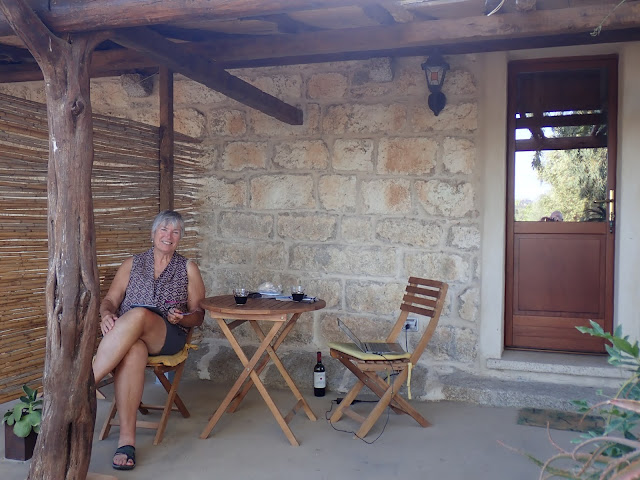We have spent the past 10 days in the Puglia region of Italy. Almost everywhere we drove outside of the cities and towns, we saw either vineyards or olive tree orchards on the side of the road, so we were never worried about being lost. We have been enjoying the finished products, along with the fabulous fresh seafood along the coast.
Our first stop was in Bari, a port city on the Adriatic Sea. The city has a rich and colourful past, being founded by the Greeks and then taken over by the Romans in the 3rd century BC, and other conquerors later, a history prevalent in the Puglia area. It is fascinating to see evidence and read about the ancient times and various rulers, especially for those of us from such a young and peaceful country. Bari's Old Town, like all the others was a joy to walk around with very few vehicles challenging the narrow and curvy alleyways. We made a daytrip to the inland city of Altamura, famous for its ornate Cathedral and heavenly bread. In older times with fewer ovens available neighbours worked together to bake, hand moulding bread dough in odd shapes so they knew who the loaves belonged to. The tradition continues today and the taste was great.
From Bari, we slid down the coast further south, making short stops into both Polignano a Mare and Monopoli, both seaside towns with a heavy wind day causing the waves to crash into the rocky cliffs with the town immediately above. It was captivating to watch the inevitable erosion and wonder how much longer the cliffside homes, some with concrete decks overhanging the cliff wall, would survive. Later on we saw coastal pictures of nice, sunny days with very little wave action and altered our initial opinions. We then drove inland for a one night stay in Alberobello, filled with odd shaped trulli homes. The huts consisted of white limestone walls with conical roofs stone slab roofs on top. Legend has it that the rooftops, put together without mortar, were easy to take down when the 15th century tax collector came to town, and then reassemble when he left. True or not, the stone rooftop kept the tiny homes cool in the summer and warm in the winter.
Our next stop was in Lecce, inland from the east coast. Lecce has a nice Old Town and we spent a day passeggiando (strolling around) the multitude of immaculately adorned churches (baroque style) and a couple of ancient Roman amphitheatres, one of which held 25,000 people in it's day. being inland the old town was not built on a hill so it was very easy to walk through the many alleyways and occasionally get lost. On another day we toured around the south end of the Salento Peninsula making multiple stops but the best ones were Otranto (east coast) and Gallipoli (west coast), both lovely places to visit. One of the highlights in Gallipoli was entering the seaside moated castle and watching an impressive 360 degree video displayed on the stone dome of a large room within the castle, depicting the history of the region.
From Lecce, it was on to Matera but not before stopping in Taranto on our way, where the Old Town was on an island in a bay with bridges on both sides moving traffic over to the small island. Avoiding the tiny old town roads we opted for a mainland parking spot close to one of the bridges and then spent a couple of hours wandering around the history in front of us. Matera though, was the highlight of our SE Italy trip, dating back to the 15th century BC and now a UNESCO World Heritage site. Carved out of rocky slopes on a steep mountain it was filled with sorrowful beauty. Residents lived in rock hewn caves with their farm animals up until the middle of the 20th century when misery and unsanitary conditions forced the government to build homes and relocate the citizens close to the valley fields they farmed, kilometres away. More recently the caves were upgraded by businesses (shops, restaurants and hotels), creating a flourishing flow of tourists starting in 2014. The city is a maze of zigzagging staircases, winding alleyways and cave dwellings but it was good exercise (Pocahontas kept calling it something quite different) and well worth it for not only the views but the history lesson. We spent two full days exploring different sides of the old town, Sasso Caveoso and Sasso Barisano. It was a magical and unique landscape that we were glad to have encountered.
That marked the end of our Italy adventure this time around. Beyond Matera, our highlights included Arzachena, Alghero and Santadi (Sardinia), Polignano a Mare, Lecce and Otranto (mainland). Tomorrow we will fly to Malta, a tiny country with a lot of history in the middle of the Mediterranean.
Ciao.
 |
| The Otranto Castle and it's moat. The rooms inside the castle were well documented so it made for an interesting visit. |
 |
| We stopped for lunch while visiting Gallipoli on the Ionian Sea coast. Most of our meals in Italy have been consumed outside with the lovely weather we have experienced. |
 |
| This was the smaller of the two Roman amphitheatres in Lecce, a city with history that we could only dream about. |
 |
| One of the main squares in the old city of Matera. Underneath the square was a massive rainwater collection system (Palombaro del Caveoso) that was only discovered within the last 50 years. Upon |






















